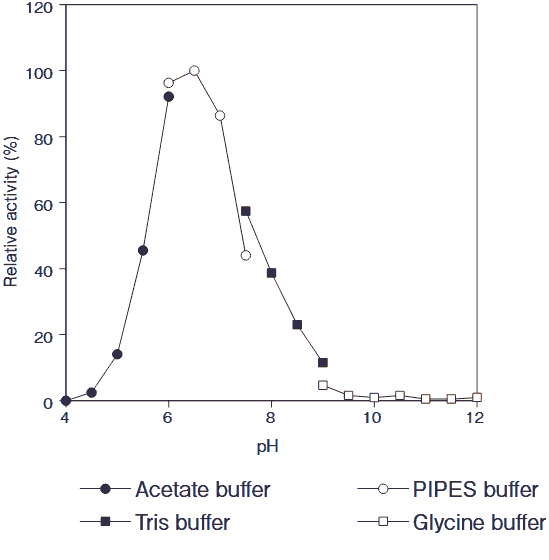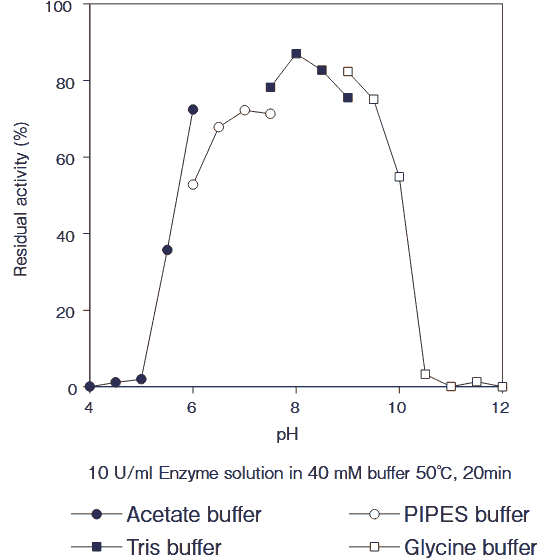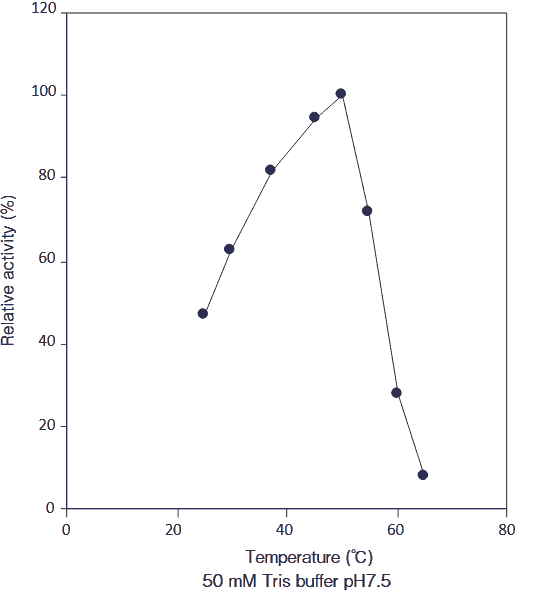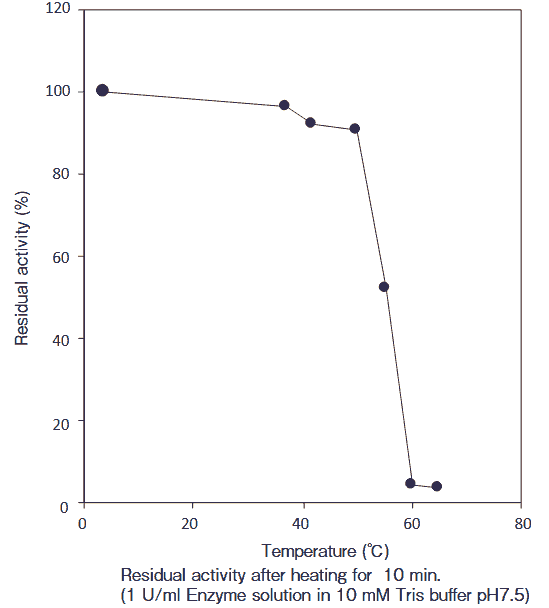FRUCTOSYLAMINE OXIDASE[FOD III]
from Microorganism
(Ketoamine oxidase, EC 1.5.3)
D‒Glucose + acceptor → D‒glucono‒1,5-lactone + reduced acceptor
Preparation and Specification
- Appearance
- : Yellowish lyophilized powder
- Specific activity
- : More than 10 U/mg solid
Properties
- Molecular weight
- : 49 kDa (SDS-PAGE)
- Michaelis constant
- : 1.61 × 10-3M (Fructosyl valylhistidine)
- Optimum pH
- : See Figure 1
- pH stability
- : See Figure 2
- See Figure 2
- : See Figure 3
- Thermal stability
- : See Figure 4
- Substrate specificity
- : See Table 1
- Effect of various chemicals on FOD Ⅲ activity
- : See Table 2 and Table 3
Applications for Diagnostic Test
This enzyme is useful for the measurement of the glycated hemoglobin (HbA1c) in human whole blood.
Fig.1 Optimum pH

Fig.2 pH Stability

Fig.3 Optimum Temperature

Fig.4 Thermal Stability

Table 1. Substrate specificity
| Substrate | Relative activity (%) |
|---|---|
| Fructosyl Valine | 436.0 |
| Fructosyl Valine-Histidine | 100.0 |
| Fructosyl Valine-Leucine | 0.9 |
| Fructosyl Valine-Histidine-Leucine | 0.0 |
| Fructosyl Valine-Histidine-Leucine-Threonine | 0.0 |
| Fructosyl Valine-Histidine-Leucine-Threonine-Proline | 0.0 |
| Fructosyl Valine-Leucine-Threonine-Proline-Leucine | 0.0 |
Table 2. Effect of various chemicals on FODIII activity
| Additives | Concentration | Relative activity (%) |
|---|---|---|
| None | - | 100 |
| MgCl2 | 0.5mM | 101 |
| MnCl2 | 0.5mM | 103 |
| CaCl2 | 0.5mM | 103 |
| LiCl | 0.5mM | 103 |
| NaCl | 0.5mM | 110 |
| CoCl2 | 0.5mM | 12 |
| CoCl2 | 0.5mM | 44 |
| KCl | 0.5mM | 107 |
| EDTA | 1mM | 109 |
| TritonX-100 | 0.1% | 100 |
| Sodium cholate | 0.1% | 98 |
| Tween 80 | 0.1% | 103 |
| Tween 60 | 0.1% | 103 |
| Briji 35 | 0.1% | 105 |
Table 3. Effect of various chemicals on FODIII activity
| Additives | Concentration | Relative activity (%) |
|---|---|---|
| None | - | 100 |
| KCl | 1mM | 101 |
| 20mM | 95 | |
| 100mM | 84 | |
| NaCl | 1mM | 97 |
| 20mM | 93 | |
| 100mM | 86 | |
| 250mM | 68 | |
| Sodium lauryl sulfate4 | 0.01% | 94 |
| 0.03% | 77 | |
| 0.05% | 3 | |
| 0.10% | 0 | |
| Ethylene glycol | 1% | 89 |
| 2% | 76 | |
| 5% | 57 | |
| 10% | 39 | |
| 20% | 17 | |
| Dimethyl Sulfoxide | 1% | 87 |
| 2% | 77 | |
| 5% | 61 | |
| 10% | 42 | |
| 20% | 22 | |
| 2-Hydroxypropyl-β-cyclodextrin | 1% | 97 |
| 3% | 92 | |
| 5% | 111 |
Table 4. Effect of various chemicals on FODIII stability
| Additive | Residual activity (%) |
|---|---|
| None (40mM Tris-HCl pH7.5) | 71 |
| + 5mM EDTA | 85 |
| + 250mM KCl | 85 |
| + 250mM NaCl | 89 |
| + 20mM Sodium glutamate | 85 |
| + 20% Sucrose | 94 |
| + 20% Ethylene glycol | 86 |
| + 20% Glycerol | 91 |
| + 0.1% Triton X-100 | 64 |
| + 4% Sorbitol | 99 |
| + 0.1% Briji 35 | 65 |
| + 0.1% Tween 60 | 74 |
| + 0.002mM Flavin adenine dinucleotide | 76 |
| + 0.02mM Flavin adenine dinucleotide | 76 |
| + 0.002mM Flavin mononucleotide | 75 |
| + 0.02mM Flavin mononucleotide | 74 |
| + 10mM NH4Cl | 77 |
(3U/ml Enzyme solution)
Assay
Principle
The assay is based on the increase in absorbance at 555 nm as the formation of quinoneimine dye proceeds in the following reactions:
| FOD Ⅲ | ||
| 1-deoxyfructosyl-valinyl- | → | Glucosone+Valinyl-histidine+H2O |
| POD | ||
| 2H2O2+4–AA+TOOS | → | quinoneimine dye+4H2O |
Unit definition
One unit is defined as the amount of enzyme which converts 1 μ mole of deoxyfructosyl-valinyl-histidine to H2O2 per minute at 37 ℃ under the conditions specified in the assay procedure.
Reagents
- Reaction mixture
50mM Tris-HCl buffer pH 7.5 containing 1.0mM 1-deoxyfructosyl-valinyl-histidine and 0.03% 4-AA and 0.02% TOOS and 5.0U/mL POD - Reaction stopper
0.5% SDS solution - Enzyme dilution buffer
10mM Tris-HCl buffer pH7.5 - Reagents
Tris (hydroxymethyl) aminomethane: Sigma #T-1503
1-deoxyfructosyl-valinyl-histidine:Peptide Institute. Inc.
4-AA (4-Aminoantipyrine) : nacalai tesque #01907-52
TOOS (N-Ethyl-N-(2-hydroxy-3-sulfopropyl)-3-methylaniline, sodium salt, dihydrate) : DOJINDO LABORATORIES #OC13
SDS (Sodium lauryl sulfate) : nacalai tesque #31606
POD (Peroxidase) : Sigma Type Ⅱ #P-8250
Enzyme solution
Accurately weigh about 20 mg of the sample and add enzyme dilution buffer to make a total of 20 ml. Dilute it with enzyme dilution buffer to adjust the concentration as required.
Procedure
- Pipette accurately 0.5 ml of reaction mixture into a small test tube and preincubate at 37 ℃.
- After 5 min, add 10 μl of enzyme solution and mix to start the reaction at 37 ℃.
- At 5min after starting the reaction, add 1.0 ml of reaction stopper and mix to stop the reaction.
※ IIn the case of a test blank, add 10 μl of enzyme dilution buffer in place of enzyme solution after stopping the reaction. - Measure the absorbance at 555 nm.
Absorbance sample : As
blank : Ab
△ A = (As−Ab) ≦ 0.050 ~ 0.800 Abs
Calculation
- Activity (U/mg of powder) = {(△A/5min)/(39.2×1/2)} × 1.51/0.01 × 1/X
= (△A/min×1.541)/X 39.2 : millimolar extinction coefficient of quinoneimine dye at 555 nm (cm2/ μmole) 1/2 : a multiplier derived from the fact that 2 mole of H2O2 produces 1 mole of quinoneimine dye 1.51 : final volume (ml) 0.01 : volume of enzyme solution (ml) X : concentration of the sample in enzyme solution(mg/ml)
Storage
Storage at -20 ℃ in the presence of a desiccant is recommended.
FOD Ⅲ活性測定法(Japanese)
試薬液
- 反応試薬混合液
1.0mM 1-deoxyfructosyl-valinyl-histidine、0.03% 4-AA、0.02% TOOS、5.0U/ml POD を含む50mM トリス-HCl 緩衝液 pH7.5 - 反応停止液
0.5% SDS 溶液 - 酵素溶解希釈溶液
10mM トリス-HCl 緩衝液 pH7.5 - 試薬
トリス (ヒドロキシメチル) アミノメタン:シグマ製 #T-1503
- 1-deoxyfructosyl-valinyl-histidine:ペプチド研究所製
4-AA (4- アミノアンチピリン) :ナカライテスク製 特級 #01907-52
TOOS:同仁化学製 #OC13
SDS (ドデシル硫酸ナトリウム) :ナカライテスク製 #31606
POD (パーオキシダーゼ) :シグマ製 Type Ⅱ #P-8250
酵素試料液
- 検品約20mg を精密に量り、酵素溶解希釈用液に溶解して全容20ml とする。その液を酵素溶解希釈用液で適宜希釈する。
測定操作法
- 小試験管に反応試薬混合液0.5ml ずつを正確に分注し、37℃で予備加温する。
- 5 分経過後、酵素試料液10 μl を正確に加えて混和し、37℃で反応を開始する。
- 5 分経過後、反応停止液1.0ml を加えて混和し、反応を停止する。
※ 盲検は反応停止後に酵素試料液10 μl を加える。 - 555nm における吸光度を測定する。
求められた吸光度を試料液についてはAs、盲検液についてはAb とする。※ 吸光度範囲 ΔA = ( As - Ab ) = 0.050 ~ 0.800Abs
計算
活性 (U/mg) = {(△A/5min)/(39.2×1/2)} × 1.51/0.01 × 1/X={(△A/min)×1.541}/X
| 39.2 : | キノンイミン色素の555nm におけるミリモル分子吸光係数 (cm2/μmol) |
| 1/2 : | H2O2 2 モルからキノンイミン色素1 モルが生成することによる係数 |
| 1.51 : | 反応総液量 (ml) |
| 1.51 : | 反応に供した酵素試料液量 (ml) |
| X : | 酵素試料液中の検品濃度 (mg/ml) |
